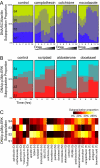Characterizing heterogeneous cellular responses to perturbations
- PMID: 19052231
- PMCID: PMC2614757
- DOI: 10.1073/pnas.0807038105
Characterizing heterogeneous cellular responses to perturbations
Abstract
Cellular populations have been widely observed to respond heterogeneously to perturbation. However, interpreting the observed heterogeneity is an extremely challenging problem because of the complexity of possible cellular phenotypes, the large dimension of potential perturbations, and the lack of methods for separating meaningful biological information from noise. Here, we develop an image-based approach to characterize cellular phenotypes based on patterns of signaling marker colocalization. Heterogeneous cellular populations are characterized as mixtures of phenotypically distinct subpopulations, and responses to perturbations are summarized succinctly as probabilistic redistributions of these mixtures. We apply our method to characterize the heterogeneous responses of cancer cells to a panel of drugs. We find that cells treated with drugs of (dis-)similar mechanism exhibit (dis-)similar patterns of heterogeneity. Despite the observed phenotypic diversity of cells observed within our data, low-complexity models of heterogeneity were sufficient to distinguish most classes of drug mechanism. Our approach offers a computational framework for assessing the complexity of cellular heterogeneity, investigating the degree to which perturbations induce redistributions of a limited, but nontrivial, repertoire of underlying states and revealing functional significance contained within distinct patterns of heterogeneous responses.
Conflict of interest statement
The authors declare no conflict of interest.
Figures




Similar articles
-
Patterns of basal signaling heterogeneity can distinguish cellular populations with different drug sensitivities.Mol Syst Biol. 2010 May 11;6:369. doi: 10.1038/msb.2010.22. Mol Syst Biol. 2010. PMID: 20461076 Free PMC article.
-
In vitro investigations of new therapeutic agents on bladder tumor cell lines.Urol Res. 1997;25(4):247-50. doi: 10.1007/BF00942093. Urol Res. 1997. PMID: 9286032
-
Intratumor heterogeneity alters most effective drugs in designed combinations.Proc Natl Acad Sci U S A. 2014 Jul 22;111(29):10773-8. doi: 10.1073/pnas.1323934111. Epub 2014 Jul 7. Proc Natl Acad Sci U S A. 2014. PMID: 25002493 Free PMC article.
-
[Anticancer drugs and pharmacologic actions].Nihon Rinsho. 1997 May;55(5):1017-23. Nihon Rinsho. 1997. PMID: 9155146 Review. Japanese.
-
Tumour heterogeneity and metastasis at single-cell resolution.Nat Cell Biol. 2018 Dec;20(12):1349-1360. doi: 10.1038/s41556-018-0236-7. Epub 2018 Nov 26. Nat Cell Biol. 2018. PMID: 30482943 Free PMC article. Review.
Cited by
-
Interactive machine learning for fast and robust cell profiling.PLoS One. 2020 Sep 11;15(9):e0237972. doi: 10.1371/journal.pone.0237972. eCollection 2020. PLoS One. 2020. PMID: 32915784 Free PMC article.
-
Tissue Imaging and Quantification Relying on Endogenous Contrast.Adv Exp Med Biol. 2021;3233:257-288. doi: 10.1007/978-981-15-7627-0_12. Adv Exp Med Biol. 2021. PMID: 34053031 Review.
-
Assignment of unimodal probability distribution models for quantitative morphological phenotyping.BMC Biol. 2022 Mar 31;20(1):81. doi: 10.1186/s12915-022-01283-6. BMC Biol. 2022. PMID: 35361198 Free PMC article.
-
Single-cell RNA profiling identifies diverse cellular responses to EWSR1/FLI1 downregulation in Ewing sarcoma cells.Cell Oncol (Dordr). 2022 Feb;45(1):19-40. doi: 10.1007/s13402-021-00640-x. Epub 2022 Jan 7. Cell Oncol (Dordr). 2022. PMID: 34997546 Free PMC article.
-
Beyond genetics in personalized cancer treatment: assessing dynamics and heterogeneity of tumor responses.Per Med. 2013 May 1;10(3):221-225. doi: 10.2217/pme.13.6. Per Med. 2013. PMID: 24696699 Free PMC article. No abstract available.
References
-
- Bahar R, et al. Increased cell-to-cell variation in gene expression in ageing mouse heart. Nature. 2006;441:1011–1014. - PubMed
-
- Bar-Even A, et al. Noise in protein expression scales with natural protein abundance. Nat Genet. 2006;38:636–643. - PubMed
-
- Colman-Lerner A, et al. Regulated cell-to-cell variation in a cell-fate decision system. Nature. 2005;437:699–706. - PubMed
-
- Ferrell JE, Jr, Machleder EM. The biochemical basis of an all-or-none cell fate switch in Xenopus oocytes. Science. 1998;280:895–898. - PubMed
Publication types
MeSH terms
Substances
Grants and funding
LinkOut - more resources
Full Text Sources
Other Literature Sources

